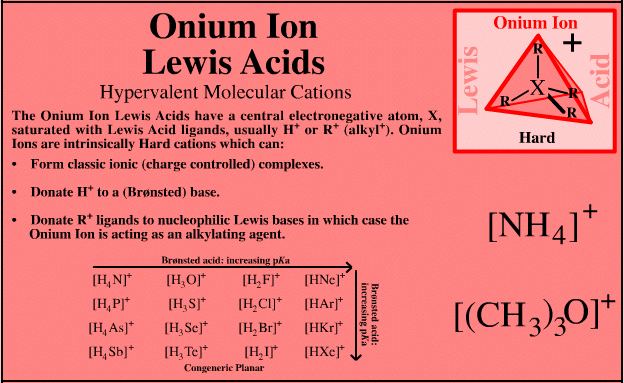 | ||
In chemistry, an onium ion, is a cation formally obtained by the protonation of mononuclear parent hydride of a pnictogen (group 15 of the periodic table), chalcogen (group 16), or halogen (group 17). The oldest-known onium ion, and the namesake for the class, is ammonium, NH+
4, the protonated derivative of ammonia, NH
3.
Contents
- Group 15 pnictogen onium cations
- Group 16 chalcogen onium cations
- Group 17 halogen onium cations halonium ions H2X protonated hydrogen halides
- Pseudohalogen onium cations
- Group 14 carbon group onium cations
- Group 13 boron group onium cations
- Group 18 noble gas onium cations
- Hydrogen onium cation
- Onium cations with monovalent substitutions
- Onium cations with polyvalent substitutions
- Double onium dications
- Enium cations
- References
The name onium is also used for cations that would result from the substitution of hydrogen atoms in those ions by other groups, such as organic radicals, or halogens; such as tetraphenylphosphonium, (C
6H
5)
4P+
. The substituent groups may be divalent or trivalent, yielding ions such as iminium and nitrilium.
A simple onium ion has a charge of +1. A larger ion that has two onium ion subgroups is called a double onium ion, and has a charge of +2. A triple onium ion has a charge of +3, and so on.
Compounds of an onium cation and some other negative ion are known as onium compounds or onium salts.
Onium ions and onium compounds are inversely analogous to -ate ions and ate complexes:
Group 15 (pnictogen) onium cations
4 (protonated ammonia (IUPAC name azane))
4 (protonated phosphine)
4 (protonated arsine)
4 (protonated stibine)
4 (protonated bismuthine)
Group 16 (chalcogen) onium cations
3O+
(protonated water (IUPAC name oxidane). Oxonium is better known as hydronium, though hydronium implies a solvated or hydrated proton. It may also be called hydroxonium.)
3S+
(protonated hydrogen sulfide)
3Se+
(protonated hydrogen selenide)
3Te+
(protonated hydrogen telluride)
Group 17 (halogen) onium cations, halonium ions, H2X+ (protonated hydrogen halides)
2F+
(protonated hydrogen fluoride)
2Cl+
(protonated hydrogen chloride)
2Br+
(protonated hydrogen bromide)
2I+
(protonated hydrogen iodide)
Pseudohalogen onium cations
2N+
3 (protonated hydrogen azide)
2CN+
(protonated hydrogen cyanide)
Group 14 (carbon group) onium cations
All are carbonium ions.
nH+
2n+3 (protonated alkanes)
5 (protonated methane) (Sometimes called carbonium, because it is the simplest member of that class, but that use is deprecated because of multiple definitions [1]. Sometimes called methonium, but methonium also has multiple definitions. Abundant in outer space.)
2H+
7 (protonated ethane)
3H+
9 (propane protonated on an unspecified carbon)
4H+
11 (butane protonated on an unspecified carbon)
8H+
19 (protonated octane)
nH+
2n+1 (n >= 2) (protonated alkenes)
2H+
5 (protonated ethene)
nH+
2n-1 (n >= 2) (protonated alkynes)
2H+
3 (protonated ethyne)
5 (protonated silane. Should not be called siliconium.[2])
nH+
2n+3 (protonated silanes)
2H+
7 (protonated disilane)
5 (protonated germane)
3 (protonated SnH
2; not protonated stannane SnH
4)
3 (protonated PbH
2)
Group 13 (boron group) onium cations
4 (protonated borane)
xH+
y (protonated boranes)
Group 18 (noble gas) onium cations
(protonated helium), expected in outer space, but not yet detected
(protonated neon)
(protonated argon)
(protonated krypton)
(protonated xenon)
Hydrogen onium cation
3 (protonated [molecular] or [diatomic] hydrogen), found in ionized hydrogen and interstellar space
Onium cations with monovalent substitutions
3N+
or RNH+
3 (protonated primary amines)
3OH+
(protonated hydroxylamine)
3NH+
3 (protonated methylamine)
2H
5NH+
3 (protonated ethylamine)
2NH+
3 (protonated hydrazine, a.k.a. diazane)
2NH+
2 (protonated secondary amines)
3)
2NH+
2 (protonated dimethylamine)
2H
5)
2NH+
2 (protonated diethylamine)
2H
5CH
3NH+
2 (protonated ethylmethylamine)
2H
4OH)
2NH+
2 (protonated diethanolamine)
3NH+
(protonated tertiary amines)
3)
3NH+
(protonated trimethylamine)
2H
5)
3NH+
(protonated triethylamine)
4N+
or NR+
4
3)
4N+
2H
5)
4N+
3H
7)
4N+
4H
9)
4N+
or abbreviated Bu
4N+
3)
3RN+
10H
21)
2(CH
3)
2N+
3)
2N(CH
3)+
3
4
4P+
or PR+
4
6H
5)
4P+
2SH+
(protonated sulfides)
3)
2SH+
(protonated dimethyl sulfide)
3S+
3)
3S+
2F+
2F+
3 (XeF
2 is neutral.)
Onium cations with polyvalent substitutions
2
6H
5)
3P)
2N+
5H
5NH+
(protonated pyridine)
5H
5O+
Double onium dications
Enium cations
The extra bond is added to a less-common parent hydride, a carbene analog, typically named -ene or -ylene, which is neutral with 2 fewer bonds than the more-common hydride, typically named -ane or -ine.
2B+
(protonated borylenes a.k.a. boranylidenes)
3C+
(protonated carbenes)
3C+
(protonated methylene)
3Si+
(protonated silylenes)
2N+
(protonated nitrenes)
2P+
(protonated phosphinidene)
3Hg+
(protonated organomercury compounds; formed as intermediates in oxymercuration reactions)
